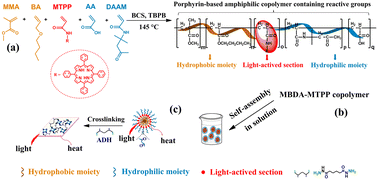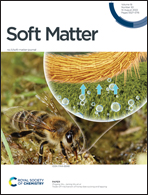A photothermally triggered one-component shape memory polymer material prepared by cross-linking porphyrin-based amphiphilic copolymer self-assemblies†
Abstract
Photothermally triggered shape memory polymer materials are usually prepared by dispersing photothermally responsive fillers or compounds into shape memory polymer matrixes through physical blending, while the migration and non-biodegradability of the fillers limit their potential applications (e.g., in the biomedical field). Here, we synthesized a new type of porphyrin-based amphiphilic random copolymer bearing a reactive moiety of carbonyl group by co-polymerizing methyl methacrylate (MMA), butyl acrylate (BA), diacetone acrylamide (DAAM), acrylic acid (AA) and double-bonded vinyl porphyrin monomers, followed by induced self-assembly in aqueous solution to give rise to amphiphilic random copolymer nanoparticles. The nanoparticles were further crosslinked by means of adipic dihydrazide (ADH) to fabricate the photothermally triggered one-component shape memory polymer material. Compared with the most-studied multi-phase/multi-component shape memory polymer materials, the porphyrin moiety, playing the role of a photo-to-heat converter, covalently bonded into the polymer structure would certainly make it more homogeneous and more stable in principle.



 Please wait while we load your content...
Please wait while we load your content...